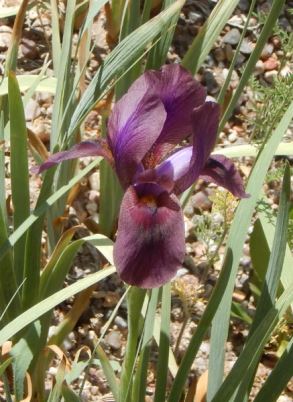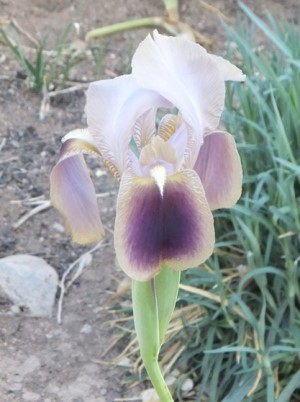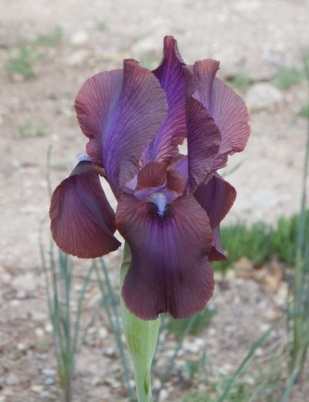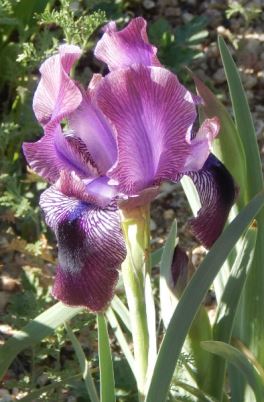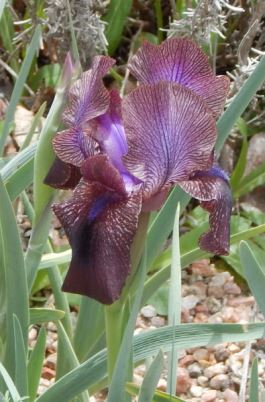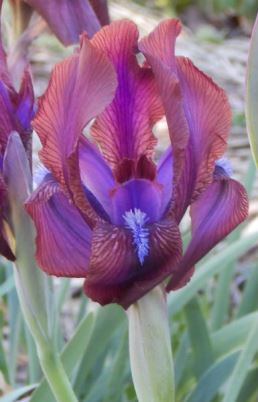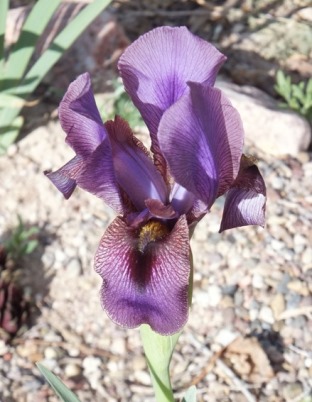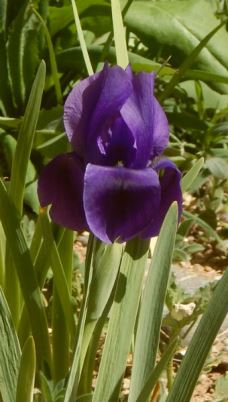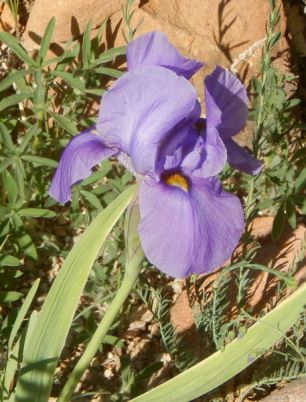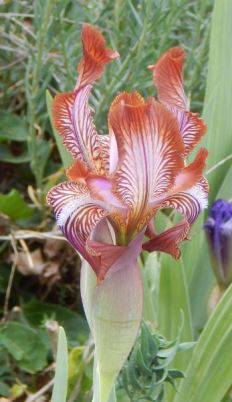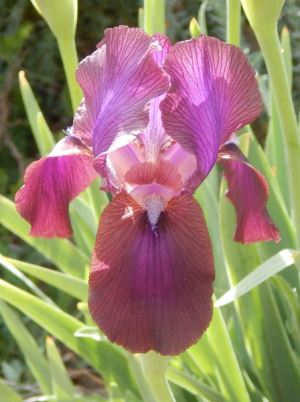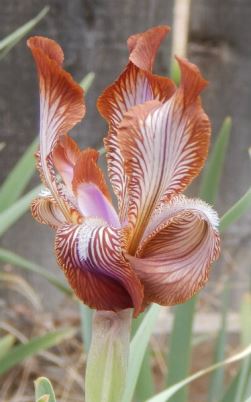|

|
Tetraploid Arils
|
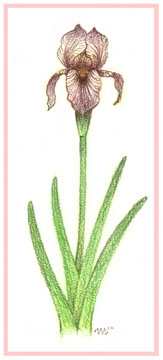
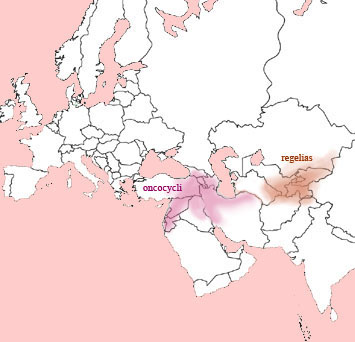 There are two types of aril irises: the oncocyclus that range from
the southern Caucasus through eastern Turkey, Syria, Jordan, Iran,
Lebanon, and Israel, and the Regelias from Turkestan and Afghanistan.
The oncocyclus group includes the most spectacular flowers in the
genus Iris, and has inspired the devotion of enthusiasts for
centuries. The Regelias, although less dramatic, are nonetheless
interesting irises, with their elongated petals and unusual coloring.
Two of the Regelia species, Ii. hoogiana and
stolonifera, are natural tetraploids with 44 chromosomes. The
other Regelias are diploids, as are all oncocycli, with 20
chromosomes. Although the Regelias have chromosomes in sets of 11 and
the oncocycli in sets of 10, the chromosomes pair readily and diploid
or tetraploid hybrids are usually perfectly fertile.
There are two types of aril irises: the oncocyclus that range from
the southern Caucasus through eastern Turkey, Syria, Jordan, Iran,
Lebanon, and Israel, and the Regelias from Turkestan and Afghanistan.
The oncocyclus group includes the most spectacular flowers in the
genus Iris, and has inspired the devotion of enthusiasts for
centuries. The Regelias, although less dramatic, are nonetheless
interesting irises, with their elongated petals and unusual coloring.
Two of the Regelia species, Ii. hoogiana and
stolonifera, are natural tetraploids with 44 chromosomes. The
other Regelias are diploids, as are all oncocycli, with 20
chromosomes. Although the Regelias have chromosomes in sets of 11 and
the oncocycli in sets of 10, the chromosomes pair readily and diploid
or tetraploid hybrids are usually perfectly fertile.
Tetraploid arils would be expected to produce
fertile seedlings when crossed with the 48-chromosome bearded irises
or with I. pumila, thus bypassing the sterility barriers that
arise when the diploid arils are used. There are a few tetraploid
aril hybrids with some oncocyclus ancestry, of which 'Persian Pansy'
is an early example. In the 1970s and 1980s, John Holden and Sam
Norris used colchicine to induce tetraploidy in oncocyclus and
oncogelia hybrids.The process is a difficult one, as many seedlings
either die or revert to the diploid state. Eventually, though, a
number of tetraploid seedlings of mostly oncocyclus ancestry were
produced, and a small handful were named and registered.
It is unlikely that anyone will take up the
work with colchicine again soon, so expanding the genetic base of
this family requires crossing diploids with the available
tetraploids, and hoping for an unreduced gamete or a triploid
seedling with enough fertility to continue the line. This is
extremely important work, not only to facilitate arilbred breeding,
but because the oncocycli have very narrow habitats in a region of
the world threatened by war and development.
My own priority with this group is crossing
the tetraploid arils with I. pumila and 48-chromosome medians
to produce fertile arilbred dwarfs and medians. At the same time, I
am crossing them with as many different oncocyclus species and
hybrids as I am able to grow, in the hope of obtaining an occasional
tetraploid. Given the difficulty of the crosses involved and the
expected low germination rates, this is work that will require a
great deal of patience.
I've compiled a listing of tetraploid
arils that may be of use in building
a collection of these irises.
Progress to Date
This is not a prime focus of mine, though I
have made a few succesful crosses of diploid oncocyclus x tetraploid
aril. No seedlings to report on yet.
Further Reading
Tetraploid
Arils, Anyone?
(AIS blog)
In
Praise of Regelias
(AIS blog)
Hall of Fame
Bronze Beauty Van Tubergen (Van
Tubergen by Aril Society International, R. 2001) AR/RH, 20-24”
(51-61cm), E. S. pale lavender, golden bronze veining around edge,
lavender basal midrib flush; F. deep wine red, golden bronze around
edge, beards white, hairs tipped yellow. I. hoogiana x I.
stolonifera. Introduced in Holland prior to 1950; in commerce in
America as ‘Hoogiana Bronze Beauty’ also known as
‘Bronze Beauty’. [44 chr.]
The Dutch firm of Van Tubergen introduced
many aril hybrids over the years. 'Bronze Beauty' was one such. It
combines the two tetraploid Regelia species, Ii. hoogiana and
stolonifera into an attractive plant with hoogiana form
but interesting, blended coloration. I've included it in the Hall of
Fame as a kind of placeholder for the contribution of these two
species to modern tetraploid aril breeding. It was finally registered
by the Aril Society International in 2001. The long name 'Bronze
Beauty Van Turbergen' was used because 'Bronze Beauty' was already
taken, but it is unfortunately awkard. The plant has long been known
as 'Bronze Beauty' and will continue to be referred to as such in
informal contexts.
Persian Pansy (Lloyd Austin by Aril
Society, R. 1969). AR/RC, 12-16” (30-41 cm), M-L. Pansy purple,
veined deeper; yellow throat; large black signal; beard dark yellow,
tipped tan. I. nigricans x 'Late Amethyst'. Court of Iris,
1960. [42 chr.]
An accidental tetraploid resulting from an
unreduced gamete from I. nigricans, this has long been the
most onco-looking of tetraploid RCs, with form and coloration much
more reminiscent of I. nigricans than I. hoogiana. It
is fertile both ways, and has produced several registered offspring.
Even after tetraploid oncogelias were produced via colchicine
treatment, 'Persian Pansy' remains a fine and important member of the
tetraploid aril family.
Werckmeister's Beauty (Peter
Werckmeister by Sharon McAllister, R. 1992). Sdlg. 1916–1.
AR/RC, 20" (51 cm), E–M. S. lavender gray, finely veined medium
violet; F. lavender gray, intensely veined and dotted medium violet
and washed violet; deep violet signal; orange yellow beards. 'Bronze
Beauty Van Tubergen' x ('Teucros' x I. susiana). Aril Society,
1992.
This tetraploid aril was produced by crossing
'Bronze Beauty Van Tubergen' with a colchicine-induced tetraploid
oncogelia seedling. 'Werckmeister's clone #2' (unregistered) has the
same parentage, but is not a sibling, since the oncogelia parents of
the two were not the same plant, but sibling seedlings. Although
these tetraploids show their Regelia ancestry in their elongated
flower form, they carry important oncocyclus genes and have proven
durable garden plants and valuable breeders. Werckmeister's study of
the meiosis of these plants indicated that they are aneuploids,
nearer to triploid than tetraploid, despite an initial chromosome
count indicating tetraploidy. Nevertheless, many years of hybridizing
experience has verified that they breed as fully functional
tetraploid arils.
Norris T-N85G ((I. camillae x
(T-N78R: (C-N73B: (((I. susiana x Andromache) x (I. susiana
x I. gatesii)) x I. sari) x C-N73A: (('Bagdad Beauty' x
(I. susiana x Andromache)) x I. sari) x I. sari
)) x ((C-N73A x (B66T x I. sari)) x T-N78R))
Samuel Norris and John Holden produced a
substantial number of tetraploid oncogelia seedlings by line breeding
colchicine-induced tetraploids (indicated by seedling numbers
beginning with "C" in the parentage). I have rather arbitrarily
selected Norris T-N85G as a representative of this group, on account
of it being used recently by Lawrence Ransom to produce the new
tetraploid arils 'Tadzhiki Bandit' and 'Tadzhiki Eclipse'. It appears
that most of these tetraploid seedlings have been lost, although
perhaps a few are still being grown by specialists. Ransom's
"Tadzhiki brothers" are currently the most widely available
tetraploid arils with strong oncocyclus content.
Gallery
Plant List
The list below shows the name of each plant I
currently grow, the source, and the year acquired.
Illustration: 'Tel
Hashi' (Kellie '68) a tetraploid aril hybrid (I. acutiloba x
unknown).
Tom
Waters
September 2010
updated October
2019
Unless otherwise noted, all text
and illustrations copyright Tom Waters and all photographs copyright
Tom or Karen Waters. Please do not reproduce without
permission.

 There are two types of aril irises: the oncocyclus that range from
the southern Caucasus through eastern Turkey, Syria, Jordan, Iran,
Lebanon, and Israel, and the Regelias from Turkestan and Afghanistan.
The oncocyclus group includes the most spectacular flowers in the
genus Iris, and has inspired the devotion of enthusiasts for
centuries. The Regelias, although less dramatic, are nonetheless
interesting irises, with their elongated petals and unusual coloring.
Two of the Regelia species, Ii. hoogiana and
stolonifera, are natural tetraploids with 44 chromosomes. The
other Regelias are diploids, as are all oncocycli, with 20
chromosomes. Although the Regelias have chromosomes in sets of 11 and
the oncocycli in sets of 10, the chromosomes pair readily and diploid
or tetraploid hybrids are usually perfectly fertile.
There are two types of aril irises: the oncocyclus that range from
the southern Caucasus through eastern Turkey, Syria, Jordan, Iran,
Lebanon, and Israel, and the Regelias from Turkestan and Afghanistan.
The oncocyclus group includes the most spectacular flowers in the
genus Iris, and has inspired the devotion of enthusiasts for
centuries. The Regelias, although less dramatic, are nonetheless
interesting irises, with their elongated petals and unusual coloring.
Two of the Regelia species, Ii. hoogiana and
stolonifera, are natural tetraploids with 44 chromosomes. The
other Regelias are diploids, as are all oncocycli, with 20
chromosomes. Although the Regelias have chromosomes in sets of 11 and
the oncocycli in sets of 10, the chromosomes pair readily and diploid
or tetraploid hybrids are usually perfectly fertile.
